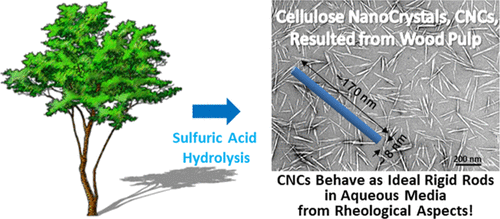当前位置:
X-MOL 学术
›
Macromolecules
›
论文详情
Our official English website, www.x-mol.net, welcomes your
feedback! (Note: you will need to create a separate account there.)
Cellulose Nanocrystals as a Model Substance for Rigid Rod Particle Suspension Rheology
Macromolecules ( IF 5.1 ) Pub Date : 2020-03-23 , DOI: 10.1021/acs.macromol.9b02641 Hikaru Hasegawa 1, 2 , Yoshiki Horikawa 1, 2 , Toshiyuki Shikata 1, 2
Macromolecules ( IF 5.1 ) Pub Date : 2020-03-23 , DOI: 10.1021/acs.macromol.9b02641 Hikaru Hasegawa 1, 2 , Yoshiki Horikawa 1, 2 , Toshiyuki Shikata 1, 2
Affiliation

|
A cellulose nanocrystal (CNC) sample with an average particle length and width of 170 and 7.8 nm, respectively, that was prepared from chemical pulp via sulfuric acid hydrolysis procedures was used as the test sample for a basic rheological study on rigid rod particle suspensions. The dynamic viscoelastic (VE) behavior of the CNC suspensions dispersed into a highly viscous aqueous sucrose solution at 60 wt % was examined over a range of concentrations (ν) in a semidilute regime at several temperatures. The obtained VE spectra were smoothly superposed onto master curves at a standard temperature of 25 °C using shift factors identical to those of the medium aqueous sucrose solution. The fundamental VE parameters, such as the zero-shear viscosity, the high frequency limiting viscosity, the average relaxation time (τw), and the reciprocal of the steady-state compliance (Je–1), were precisely determined from the master curves as functions of ν. The average rotational diffusion constant of the CNC particles dispersed into suspensions at a dilute condition, Dr0, was also determined at 25 °C using depolarized dynamic light scattering techniques. The relationship τw0 = (6Dr0)−1 was confirmed in the dilute regime, and τw ∝ ν2(6Dr0)−1 was observed in the semidilute regime as predicted by the Doi–Edwards (D–E) theory. Another relationship Je–1 = (3/5)νkBT, where kBT is the product of the Boltzmann constant and the absolute temperature, was also reasonably confirmed in the semidilute regime until the concentration approached the liquid crystal phase transition boundary, as also predicted by the D–E theory. Consequently, the CNC sample behaves as ideal model particles for the detailed study of rigid rod particle suspensions.
中文翻译:

纤维素纳米晶体作为刚性杆颗粒悬浮流变学的模型物质
由化学纸浆经硫酸水解程序制得的平均粒径分别为170和7.8 nm的纤维素纳米晶体(CNC)样品被用作测试样品,用于对刚性棒状颗粒悬浮液进行基础流变学研究。在半稀释状态下,在几个温度下,在一定浓度范围(ν)下,检查了分散在60%(重量)高粘度蔗糖水溶液中的CNC悬浮液的动态粘弹性(VE)行为。使用与中等蔗糖水溶液相同的位移因子,将获得的VE光谱在25°C的标准温度下平滑叠加到主曲线上。VE的基本参数,例如零剪切粘度,高频极限粘度,平均弛豫时间(τw),以及稳态柔量(J e –1)的倒数,是根据主曲线精确确定为ν的函数。还使用去偏振动态光散射技术在25°C下确定了在稀释条件下分散到悬浮液中的CNC颗粒的平均旋转扩散常数D r0。的关系τ W0 =(6 d R0)-1 τ被证实在稀制度,和瓦特αν 2(6 d R0)-1在如由土井-爱德华兹(d-E)所预测的亚浓政权观察理论。另一个关系JÈ -1 =(3/5)ν ķ乙Ť,其中ķ乙Ť是波尔兹曼常数,绝对温度的乘积,也合理地在亚浓政权确认直到浓度接近液晶相转变的边界,如也由D–E理论预测。因此,CNC样品可作为理想模型颗粒,用于详细研究刚性棒状颗粒悬浮液。
更新日期:2020-04-24
中文翻译:

纤维素纳米晶体作为刚性杆颗粒悬浮流变学的模型物质
由化学纸浆经硫酸水解程序制得的平均粒径分别为170和7.8 nm的纤维素纳米晶体(CNC)样品被用作测试样品,用于对刚性棒状颗粒悬浮液进行基础流变学研究。在半稀释状态下,在几个温度下,在一定浓度范围(ν)下,检查了分散在60%(重量)高粘度蔗糖水溶液中的CNC悬浮液的动态粘弹性(VE)行为。使用与中等蔗糖水溶液相同的位移因子,将获得的VE光谱在25°C的标准温度下平滑叠加到主曲线上。VE的基本参数,例如零剪切粘度,高频极限粘度,平均弛豫时间(τw),以及稳态柔量(J e –1)的倒数,是根据主曲线精确确定为ν的函数。还使用去偏振动态光散射技术在25°C下确定了在稀释条件下分散到悬浮液中的CNC颗粒的平均旋转扩散常数D r0。的关系τ W0 =(6 d R0)-1 τ被证实在稀制度,和瓦特αν 2(6 d R0)-1在如由土井-爱德华兹(d-E)所预测的亚浓政权观察理论。另一个关系JÈ -1 =(3/5)ν ķ乙Ť,其中ķ乙Ť是波尔兹曼常数,绝对温度的乘积,也合理地在亚浓政权确认直到浓度接近液晶相转变的边界,如也由D–E理论预测。因此,CNC样品可作为理想模型颗粒,用于详细研究刚性棒状颗粒悬浮液。











































 京公网安备 11010802027423号
京公网安备 11010802027423号